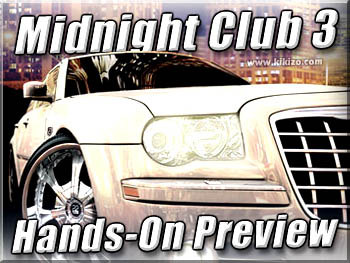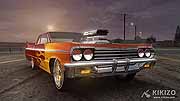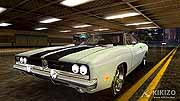Midnight Club 3: Hands-On Playtest
As the spring launch of Rockstar's anticipated street racing title approaches, we get a fresh hands-on with a recent build, in this latest preview.
| Version PS2, Xbox, PSP | Developer Rockstar San Diego | Publisher Rockstar | Genre Racing |
||||
By Adam Doree
Not so long ago we took our latest trip down to Rockstar to get some hands-on time with Midnight Club 3: DUB Edition, the racing game that seemingly offers it all: open city street racing, car customisation and extreme high-end authentic modding, all the licenses you can frisbee a hubcap at, and fully online enabled. It's a celebrated videogame franchise that we scored handsomely on its last outing - and the recent announcement of the PSP version, to release alongside the PS2 and Xbox versions, is sure to boost the game's profile further.

Since our last in-depth look at the game, a range of new stuff is on offer in the DUB Magazine-partnered (and inspired) game, but best of all, this was the first chance we'd had to actually play it, giving us a good feel for what the final experience will be like come this spring.
This specific sub-genre of racing game started in 1999 at Angel Studios - now Rockstar San Diego - with Midtown Madness 1. It was the first time gamers could really drive around in congested city streets, with one city on offer at the time - Chicago. As Rockstar's PJ Sim explains, "it forged the idea for open city racing, and this is when we recognised the possibilities". Angel fired things up with the sequel, Midtown Madness 2, in which the AI, city design and graphics had all been improved, pushing many PC gamers' machines to the limits.
It was then that Rockstar fully appreciated what could be done with open city racing, and hooked up with Angel Studios to create Midnight Club - a launch title for PlayStation 2. "We really wanted to get away from track-based racing, to have something where there are no restrictions," explains PJ, "and no arrows pointing you in a certain direction. There were a few risks with the title because PS2 development tools were in their infancy, so to have an open city and to make it look good, and technically handle as you'd expect was quite risky. But we pulled it off and came up with an open city, and it was a great start for the series to build on."
It was expanded with Midnight Club 2, which again progressed in every area - there were three cities, and it introduced "rail branching" - when the AI makes independent decisions at each junction, enhancing the replay value since no two races are the same - everyone reacts to what's going on around them. "There was a great sense of speed in the game," reflects PL, "but the graphics weren't as polished as they could have been. But essentially it was a good, fun, pick-up and play arcade racer."
"We have worked on it again, so this is obviously the fifth experience for Rockstar with open city racing, and we really feel we've hit our stride now with Midnight Club 3, addressing those issues, particularly with the graphics and the lighting model. Working with fully licensed cars, offering customisation, and obviously the partnership with DUB Magazine."
And Rockstar says that even if gamers aren't that familiar with DUB and the high-end world of car customisation, it doesn't really matter - "it's still a lot of fun to be customising all these vehicles", enthuses our man, "and they're all things you could build in real life, nothing is fictitious - but you can still create something really ridiculous of course!" Which is obviously good to know...
The DUB culture does include everything from SUVs, trucks, import tuners, high-end sports cars, concept cars, street bikes, custom choppers, muscle cars and more. And all these types of cars are in the game. In fact, the game offers over sixty licensed vehicles. twice that of MC2. "DUB is the creative consultant for the game," PJ told us, "they have told us what is relevant and what's going on - it's not just stuff we've chosen. We felt it was the perfect opportunity to put a whole new slant on the open-city racing genre."
Firing up the game, and it was time to start with one of the sixty licensed vehicles - one of the classic American Muscle cars, the Chevy Impala, a motor that really started the Muscle car era in the sixties, boasting extreme power, and which has today been made cool again by hip-hop heavies like Snoop Dog, Dr Dre and Outkast. "All the old muscle cars have been revitalised by DUB and brought back into relevance today with modern customisation that's available with rims, paint jobs and everything."
We checked out the aesthetic mods in this build, but the final game includes full performance mods as well, grouped into engine, transmission, brakes, tyres and suspension - each having several sub categories. It's really, obsessively detailed stuff. PJ enthuses, "MC3 will offer the deepest selection of customisation options ever seen in a game. Body kits, hoods, spoilers, wheels, rims, exhaust - everything you think you could customise, you can."
We started with a two-toned, faded paint job on the Impala. "MC2 was just textured paint jobs - just flat colours, this time there is a different selection of paints, and within each, there's a whole selection of colours, taking reflections in the street and everything."
We went to 'flame' category to add some additional orange flames, before adding a bit of love to the rear of the car, adding a classic spoiler. Wheels are obviously a major part of the final look, so we started with some classic Chevy rims on the car. They're all fully 3D models, not just different textures. The wheels appear much rounder, modelled with much more detail, than you would find in MC2.
Whatever upgrade combination we went for, it was pretty much guaranteed to be unique, and in the final build, it would be playable both offline and online. The game save space, at least on the PS2 version we checked out, will offer twenty slots to store modified cars in the garage, ready to get back out whenever you like.
It was time to race, so we took to the streets of Detroit. It was instantly obvious that this was a much more polished version of the game since we last checked it out in the summer of 2004. There was no damage modelling in this version, but it's something that's promised for the final build. However, damage won't affect the handling - you'll simply re-spawn when the vehicle is too damaged to continue.
Prising the controller from Rockstar's hands, we opted for a new sports car race in a Saleen S7. It was a much lighter car and if you're too heavy on the handbrake, spinning off around corners is guaranteed. The fully street-legal vehicle ramps up from 0-60 in under four seconds, and achieves over 200mph at top speed - not too shabby.
Graphically, a believable night time glow on the passing buildings was at once striking - it's a rendering process that Rockstar calls "high dynamic range", giving much more glow to lighting and shine on chrome, reacting to headlights and bringing a gritty feel to dusk and dawn. MC2 was always pretty dark, making it difficult to see, but this time the city's neon lights, much improved draw distance and refined engine all help to bring the city to life.
The visual style of the level is characterised by a foggy, overcast atmosphere, as a scripted train zooms past overhead, injecting further life to midnight Detroit. There's stuff going on all the time, making it feel more like a real city than those found in, say, the fantastic Project Gotham Racing and its sequel. There's a lot to think about, not just your opponents. Although the frame rate seemed better with bikes than with cars, it was always better than in the previous build we saw, and overall not too shoddy at all, considering the level of activity and detail in the city.
We also wanted to check out some bike racing action; not many racing games offer bikes and cars together, and Rockstar has pushed things further to include choppers and a whole selection of road bikes. Initially, the control system felt quite complicated but it wasn't long before we were riding around like a pro - well, almost.
You use L1 to 'lean', - particularly important for bikes as it helps with steering by speeding up around a bend, while R1 is your handbrake, making itself particularly helpful in performing donuts (180 degree turns) to spin around at high speed. L2 lets you look behind you, and R2 is your boost. Meanwhile, the four action buttons offer familiar racing controls, including the ability to cycle through five viewing angles, while the D-pad provides access to the street map and music selection (there was a varied and impressive selection of tracks from the five or so that we listened to).
Bikes are robust and easier to handle - you don't fly off every single time you touch something, but you still get a real sense of speed, and at the same time, this particular chopper felt quite heavy. And besides, when you do crash it can be quite fun. After a while on bike, it was time to attempt a massive jump. After positioning the bike accordingly, we performed a nitrous boost with R2, and corrected our position in the air by hitting L1. After a few attempts, we could successfully land on an adjacent building - pretty extreme stuff.
At many points felt very much like Burnout 3, with great speeds and weaving through as much traffic as possible before (for us on our first go at least) the inevitable crash occurs. Police badger you to try and get in your way, although fortunately, they'll never arrest you GTA style.
Finally, we checked out the Aprilla Mille, one of the road-style speed racing bikes - it handled slightly differently, things felt a little lighter, a touch faster and corners could be navigated a lot more sharply than in the chopper - but as a result, the bike was a little less forgiving when we smashed into things.
In the heat of a race, initially it could be quite tricky knowing exactly where to go, but then we realised it's always easy, thanks to useful translucent arrows. Of course, you can deviate from the circuit, veering off around the easily accessible city at large if you desire, but to stay on track and keep up with things, the arrows are your guide. Unless you know a better shortcut obviously...
Despite the customisation aspect of the game, the gameplay itself is still distinctly arcade styled, so it came as no surprise to take on these massive jumps and burst through buildings - stuff we probably couldn't do in real life (but never say never). "Gamers will be able to choose their direction through the game," says PJ, "whether it's a drag race on the beach, a road race down the freeway - there'll be other races to follow and police to out run, and competitions in the city at any one time, so you can roam around and choose what you want to do". It's clearly a lot more non-linear than MC2 - "some races are for money, some for other cars, and some for additional secrets, opening up some of the game's unlockables," he hints.
There are three cities to explore, although we only had the chance to race around Detroit. "You'll bounce from city to city as you go through the game, which is a deliberate change from MC2 in which you had to complete a city to move on - some players never got to see Tokyo in the game as a result."
Midnight Club 2 offered eight-player online, but now there's also some team-based modes in which you can join mid-race, detailed stats, buddy lists on both versions, and more besides. And, since there's also so much emphasis on customising your own fully unique vehicles, there's even more reason to show it off in the competitive world of online head-to-head. There's a lot more choice on offer all round, basically.
We were really having fun with MC3 and came away with a good feeling about the gameplay and production values of the game, and with the unique combination of open city racing and extreme, big-ass modding, Rockstar seems to have every chance of success with Midnight Club 3.
Although it was originally scheduled for a December release, the game has been pushed back to April - and we can reveal that it will hit shelves April 12th in the US, with the UK release set to follow on the 15th.
| Video Coverage (Latest Videos & Video FAQ) | |||
| PLEASE DO NOT DIRECT LINK TO ANY MEDIA FILE ON KIKIZO | |||
| Description | Dur. | Size | Details |
|
Midnight Club 3: DUB Edition Newest direct feed trailer! (640x480, 1.6Mbps) |
1.21min | 12.9MB | WMV |
|
Midnight Club 3: DUB Edition Direct feed trailer. (640x480, 1.6Mbps) |
1.24min | 13.8MB | WMV |



































 Satoru Iwata Video Interview - the late Nintendo president spoke with Kikizo in 2004 as 'Nintendo Revolution' loomed.
Satoru Iwata Video Interview - the late Nintendo president spoke with Kikizo in 2004 as 'Nintendo Revolution' loomed. Kaz Hirai Video Interview - the first of Kikizo's interviews with the man who went on to become global head of Sony.
Kaz Hirai Video Interview - the first of Kikizo's interviews with the man who went on to become global head of Sony. Ed Fries Video Interview - one of Xbox's founders discusses an epic journey from Excel to Xbox.
Ed Fries Video Interview - one of Xbox's founders discusses an epic journey from Excel to Xbox. Yu Suzuki, the Kikizo Interview - we spend time with one of gaming's most revered creators.
Yu Suzuki, the Kikizo Interview - we spend time with one of gaming's most revered creators. Tetris - The Making of an Icon: Alexey Pajitnov and Henk Rogers reveal the fascinating story behind Tetris
Tetris - The Making of an Icon: Alexey Pajitnov and Henk Rogers reveal the fascinating story behind Tetris Rare founders, Chris and Tim Stamper - their only interview? Genuinely 'rare' sit down with founders of the legendary studio.
Rare founders, Chris and Tim Stamper - their only interview? Genuinely 'rare' sit down with founders of the legendary studio. The History of First-Person Shooters - a retrospective, from Maze War to Modern Warfare
The History of First-Person Shooters - a retrospective, from Maze War to Modern Warfare